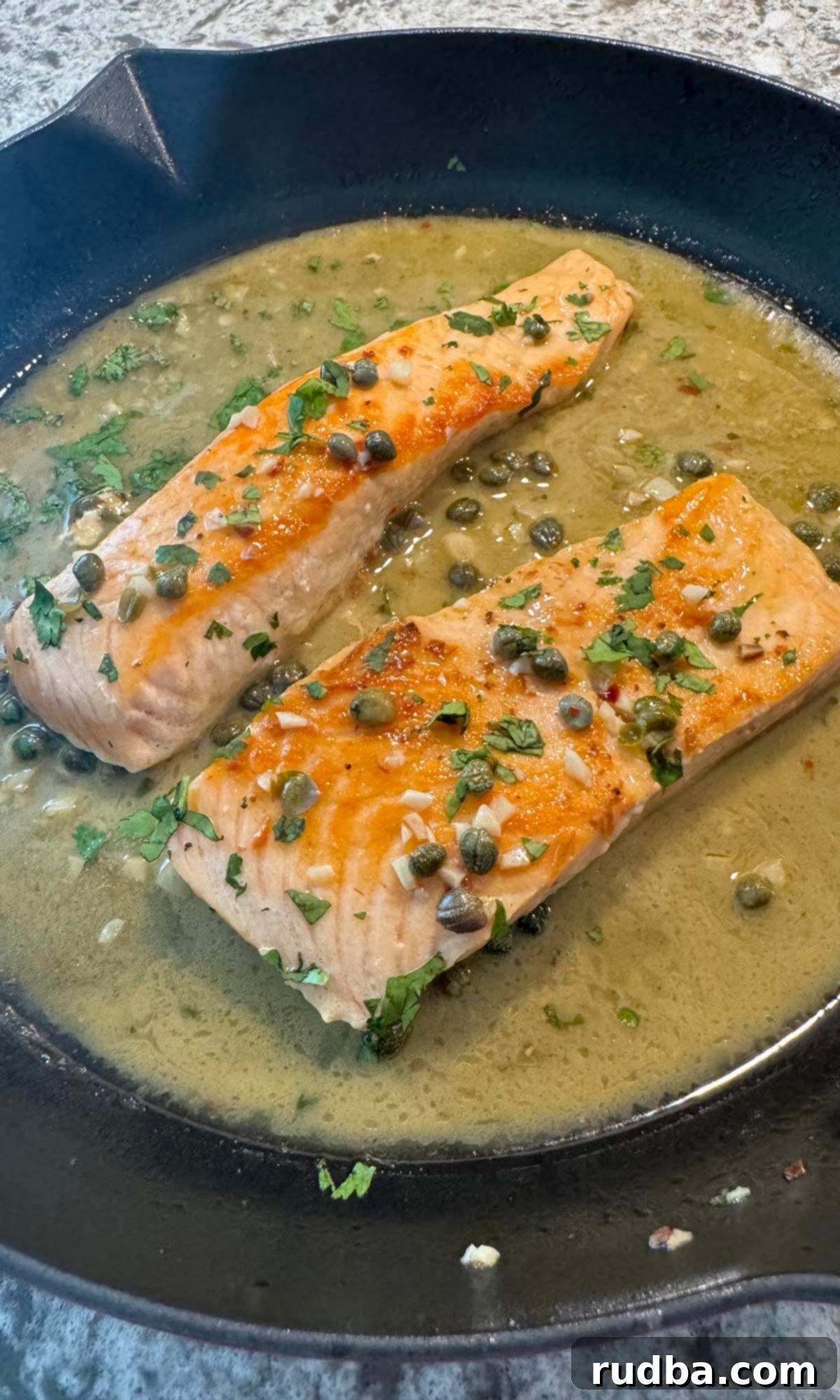Easy & Delicious Lemon Garlic Salmon Piccata: Your New Favorite Weeknight Meal
Welcome to your new favorite weeknight dinner! This Salmon Piccata recipe is an absolute dream for anyone craving a restaurant-quality meal that’s both incredibly flavorful and surprisingly quick to prepare. Imagine perfectly seared salmon fillets, drenched in a bright, zesty lemon-garlic butter sauce with the delightful briny pop of capers. It’s garlicky, lemony, and flaky – truly a dish that satisfies all your senses.
What makes this particular salmon piccata stand out is its balance of vibrant flavors and the ease of execution. It’s designed to be a culinary triumph even on your busiest evenings, coming together in less than 20 minutes from start to finish. This makes it an ideal choice for busy individuals and families looking for healthy, delicious, and quick dinner solutions. Whether you’re pairing it with creamy mashed potatoes, al dente pasta, fluffy rice, or keeping it low-carb with roasted vegetables, this salmon dish is versatile enough to complement any side.
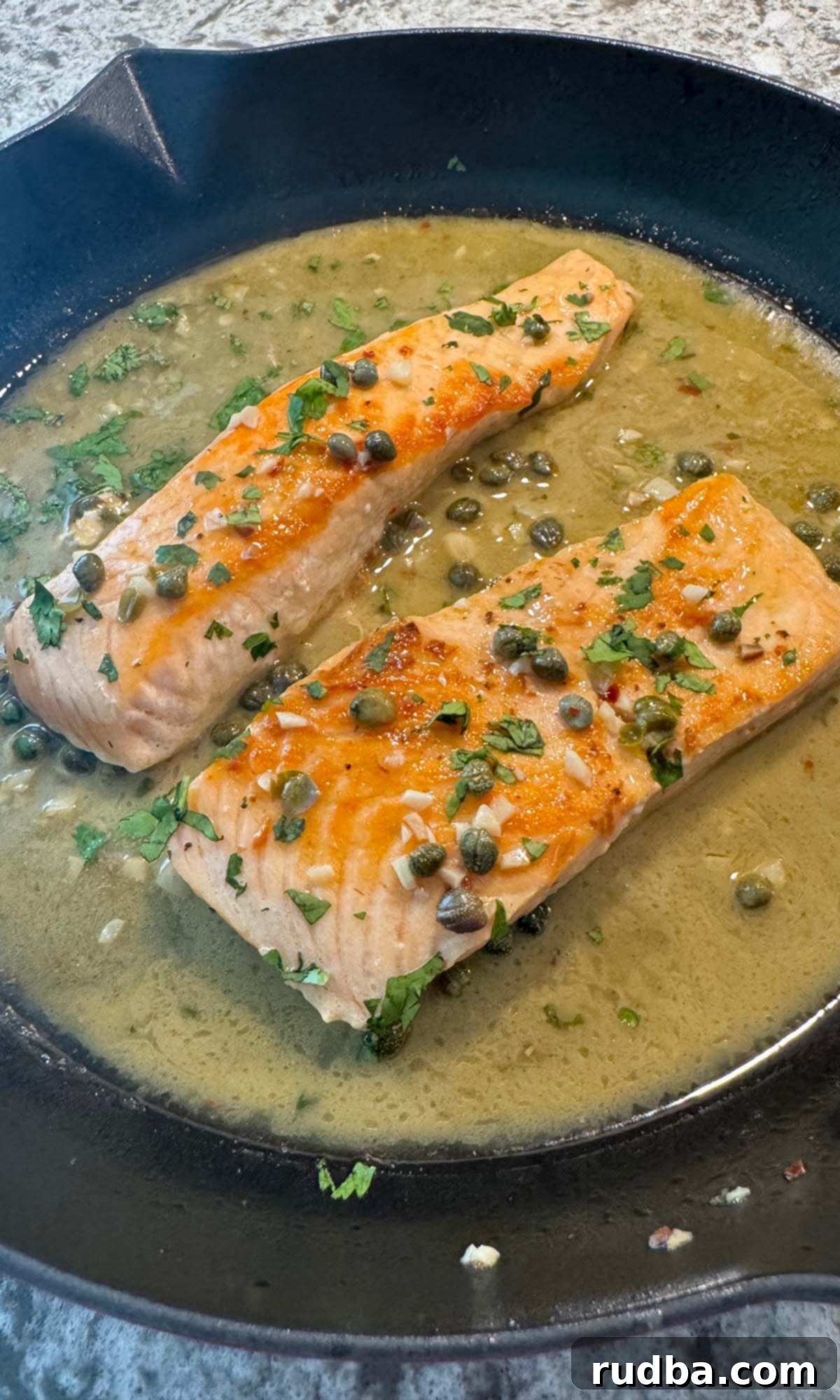
Beyond its incredible taste and speed, this salmon recipe is also a fantastic option for those following specific dietary needs. It’s naturally low-carb and keto-friendly, packed with healthy fats and protein, making it a wholesome and satisfying choice that won’t compromise your dietary goals. For more fantastic salmon ideas, don’t forget to explore our other popular recipes like this crab-stuffed salmon and simple baked salmon.
Why You’ll Love This Lemon Garlic Salmon Piccata
- Effortlessly Delicious: This recipe delivers a gourmet experience with minimal effort. The rich, tangy, and savory sauce transforms simple salmon into a truly memorable dish.
- Lightning Fast: Perfect for hectic weeknights, this meal is on your table in under 20 minutes, proving that healthy and delicious doesn’t have to mean time-consuming.
- Healthy & Wholesome: Salmon is a powerhouse of Omega-3 fatty acids, promoting heart health and brain function. Plus, this recipe is low-carb and keto-friendly, fitting beautifully into a healthy lifestyle.
- Versatile Pairing: It pairs wonderfully with a variety of sides, from classic mashed potatoes and pasta to lighter options like roasted asparagus or cauliflower rice.
- Simple Ingredients: You’ll only need a handful of readily available ingredients to create this culinary masterpiece.
Table of Contents
- INGREDIENT NOTES
- EXPERT TIPS FOR PERFECT SALMON
- SERVING SUGGESTIONS
- STORAGE & REHEATING
- FREQUENTLY ASKED QUESTIONS
- Salmon Piccata Recipe Card
Ingredient Notes for the Best Salmon Piccata
Crafting the perfect Salmon Piccata starts with understanding your ingredients. While this recipe is incredibly forgiving, a few key choices can elevate your dish from good to absolutely phenomenal.
For precise ingredient quantities and step-by-step instructions, please refer to the comprehensive recipe card located further down the page.
- Salmon: The star of our dish! You can use either farm-raised or wild-caught salmon fillets for this recipe. Both fresh and frozen salmon work beautifully, but if using frozen, ensure it’s fully thawed and patted very dry before cooking to achieve that perfect crispy skin. Always choose salmon that looks vibrant, has a firm texture, and doesn’t have any strong “fishy” odor – a fresh piece of salmon will smell clean, like the ocean. Skin-on fillets are recommended as the skin helps protect the flesh and crisps up nicely.
- Fresh Lemon: This is non-negotiable for authentic piccata flavor! Bottled lemon juice simply doesn’t compare to the bright, aromatic zest and fresh tang of a freshly squeezed lemon. You’ll use both the juice and a bit of zest to maximize that vibrant citrus punch in the sauce. The zest contains essential oils that add depth without increasing acidity.
- White Wine: A dry, non-fruity white wine is ideal here, such as Pinot Grigio, Sauvignon Blanc, or an unoaked Chardonnay. The wine adds a wonderful complexity and depth to the sauce by deglazing the pan and picking up all those delicious browned bits from the salmon. If you prefer to avoid alcohol, high-quality chicken stock or vegetable broth makes an excellent substitute, providing savory notes that beautifully complement the lemon and garlic.
- Butter: Essential for building a rich, velvety sauce. Both unsalted or salted butter can be used; just adjust any additional salt accordingly. Butter isn’t just for flavor; it’s crucial for emulsifying and thickening the piccata sauce, giving it that luxurious sheen and body. Don’t be tempted to omit it, as it’s key to the sauce’s texture and taste.
- Capers: These small, briny flower buds add a unique salty and tangy kick that is characteristic of a classic piccata. While entirely optional if they’re not to your taste, they are highly recommended for the authentic flavor profile. Rinse them lightly if you find them too salty.
- Garlic: Freshly minced garlic is vital for a fragrant and savory base for the piccata sauce. Avoid garlic powder for this recipe; the fresh aroma makes a huge difference.
- Red Pepper Flakes: A small pinch adds a subtle warmth and gentle heat, balancing the richness of the butter and the brightness of the lemon. Adjust to your personal preference, or omit if you prefer no heat.
- Fresh Parsley: Used for garnish, fresh parsley adds a pop of color and a fresh, herbaceous note that brightens the overall dish.
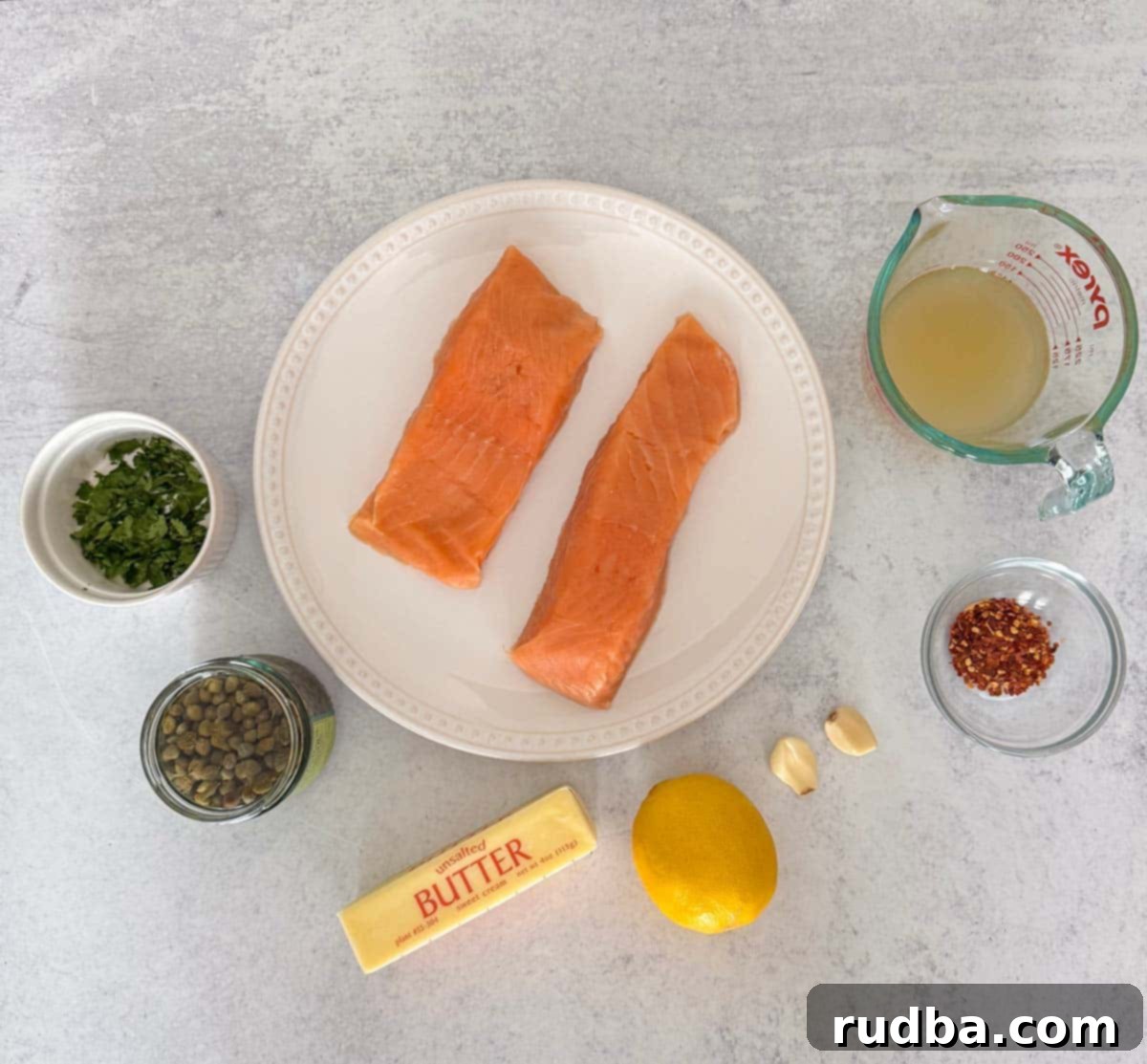
Expert Tips for Perfect Lemon Garlic Salmon Piccata
Achieving perfectly cooked, flaky salmon with an irresistible piccata sauce is simpler than you think. Follow these expert tips to ensure your dish is a showstopper every time:
- Avoid Overcooking the Salmon: This is the golden rule for any salmon recipe! Overcooked salmon becomes dry, tough, and crumbly, resembling canned tuna rather than the delicate, flaky fish we’re aiming for. Cook salmon for approximately 3-5 minutes per side over medium heat, depending on the thickness of your fillets. A good rule of thumb is to look for an internal temperature of 145°F (63°C) at its thickest part, or until the flesh easily flakes with a fork. The fish should still be slightly translucent in the very center if you prefer it medium-rare, as it will continue to cook slightly with residual heat.
- Bring Salmon to Room Temperature: For even cooking, remove your salmon fillets from the refrigerator about 15-20 minutes before you plan to cook them. Cold fish will cook unevenly, often resulting in overcooked edges and an undercooked center. Letting it rest at room temperature helps it cook more uniformly and reduces the overall cooking time.
- Season Generously and Pat Dry: Before cooking, pat your salmon fillets thoroughly dry with paper towels. This step is crucial for achieving a beautiful, crispy skin and a good sear. Then, season both sides generously with Kosher salt and freshly cracked black pepper. Don’t be shy with the seasoning; it enhances the natural flavors of the salmon and creates a delicious crust.
- Deglaze the Pan for Maximum Flavor: The moment you add the lemon juice and white wine (or chicken stock) to the skillet, make sure to scrape the bottom of the pan with a wooden spoon or spatula. Those browned bits, known as “fond,” are packed with caramelized flavors from searing the salmon and cooking the garlic. Deglazing incorporates them into your sauce, adding incredible depth and richness.
- Emulsify the Butter for a Silky Sauce: When stirring in the remaining butter at the end, gently swirl the pan or whisk continuously until the butter is fully incorporated and the sauce thickens slightly and becomes glossy. This process emulsifies the butter, creating a smooth, velvety texture that clings perfectly to the salmon. Avoid bringing the sauce to a rapid boil after adding the butter, as this can cause it to separate.
- Use a Quality Pan: A good quality skillet, preferably cast iron or stainless steel, is excellent for searing salmon and building the piccata sauce. These materials retain heat well, which is essential for a proper sear and consistent sauce development. A non-stick pan can also work, but ensure it’s adequately hot before adding the salmon.
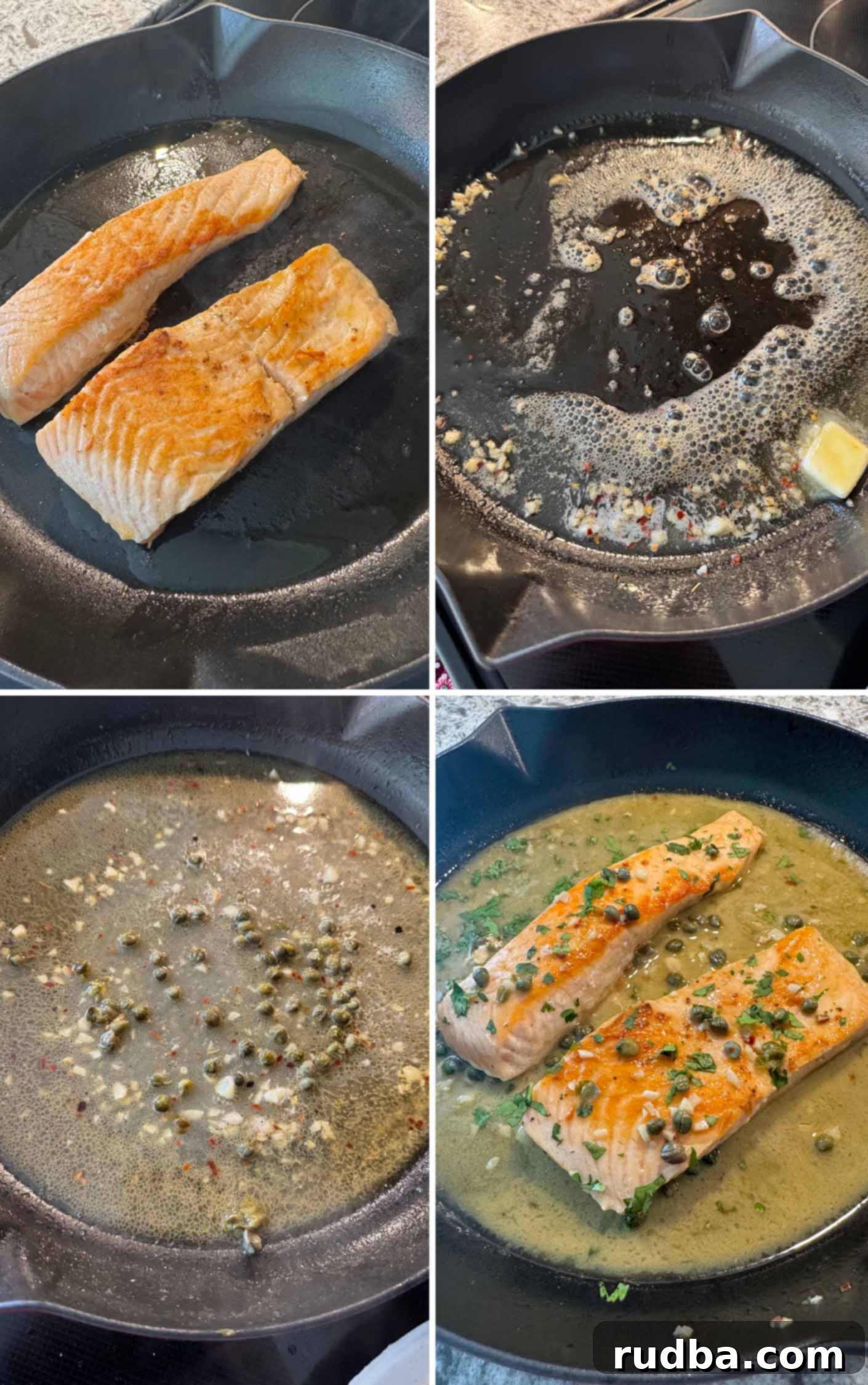
Delicious Serving Suggestions for Salmon Piccata
This Lemon Garlic Salmon Piccata is wonderfully versatile and can be paired with a myriad of side dishes to create a complete and satisfying meal. Its bright, tangy sauce complements both rich and light accompaniments.
- Classic Comfort: Serve it alongside a generous helping of our creamy mashed potatoes, allowing the potatoes to soak up every last drop of that delectable lemon-butter sauce. Fluffy white rice or a simple pilaf also makes an excellent canvas for the vibrant flavors.
- Pasta Perfection: Toss your favorite pasta (linguine, fettuccine, or angel hair work beautifully) with a little of the piccata sauce and a sprinkle of fresh parsley before topping with the salmon. The pasta soaks up the flavors, making for an incredibly satisfying dish.
- Low-Carb & Keto-Friendly Options: To keep this meal aligned with low-carb or keto diets, consider serving it with steamed or roasted asparagus, sautéed spinach, a medley of roasted seasonal vegetables, or a light and fluffy cauliflower rice. Zucchini noodles or spaghetti squash are also fantastic alternatives to traditional pasta.
- Fresh & Green: A simple, crisp green salad with a light vinaigrette provides a refreshing contrast to the richness of the salmon and sauce. A sprinkle of toasted slivered almonds on the salad adds texture.
- Crusty Bread: Don’t forget a warm, crusty baguette or artisanal bread to mop up any leftover sauce. It’s too good to let go to waste!
- Wine Pairings: Complement the dish with a crisp, dry white wine like the one used in the sauce – think Pinot Grigio, Sauvignon Blanc, or a light-bodied Chardonnay.
Storage and Reheating Instructions
While this Salmon Piccata is best enjoyed fresh, you can certainly store any leftovers to savor later. Proper storage ensures your salmon remains delicious and safe to eat.
- Refrigeration: If you have any leftovers, allow the salmon and sauce to cool completely to room temperature (within two hours of cooking). Then, transfer them to an airtight container. Refrigerate promptly for up to 2 days. Beyond this, the quality and safety may begin to diminish.
-
Reheating:
- Microwave: For a quick reheat, place the salmon and sauce on a microwave-safe plate. Cover loosely and heat in 30-second intervals until warmed through. Be careful not to overheat, as this can dry out the salmon.
- Stovetop: This is often the best method for retaining moisture. Gently reheat the salmon and sauce in a skillet over low to medium-low heat. Add a splash of chicken stock or water if the sauce appears too thick. Cover the pan to help steam the salmon and prevent it from drying out.
- Oven: If reheating a larger portion, preheat your oven to 275°F (135°C). Place the salmon and sauce in an oven-safe dish, add a tablespoon or two of liquid (water or stock), and cover tightly with foil. Reheat for 10-15 minutes, or until warmed through. This method is excellent for gentle, even reheating.
- Freezing: Freezing cooked salmon piccata is generally not recommended as the texture of the salmon can become dry and the sauce may separate upon thawing and reheating. It’s best enjoyed fresh or within a couple of days from the refrigerator.
Frequently Asked Questions About Salmon Piccata
- Q: Can I use frozen salmon for this recipe?
- A: Yes, absolutely! If using frozen salmon, ensure it’s completely thawed before cooking. Pat the fillets very dry with paper towels to remove excess moisture; this is key to getting a good sear and crispy skin. Dry salmon cooks better and absorbs the sauce more effectively.
- Q: What can I substitute for white wine?
- A: If you prefer not to use alcohol, chicken stock or vegetable broth is an excellent substitute for white wine. Choose a low-sodium broth to better control the saltiness of the final dish. The flavor profile will be slightly different, but still incredibly delicious and savory.
- Q: Are capers necessary for Salmon Piccata?
- A: Capers are a hallmark ingredient of piccata sauce, offering a unique briny, tangy, and slightly floral flavor. While they contribute significantly to the authentic taste, they are completely optional. If you’re not a fan, you can certainly omit them, and the sauce will still be wonderfully lemony and garlicky.
- Q: How do I know when my salmon is perfectly cooked?
- A: Salmon is cooked when it reaches an internal temperature of 145°F (63°C) at its thickest part. You can also tell it’s done when it easily flakes with a fork. The flesh should turn from translucent to opaque, but avoid cooking it until it’s chalky white all the way through, as this indicates overcooking.
- Q: Is this recipe spicy?
- A: The recipe includes red pepper flakes, which add a very mild hint of warmth rather than intense spiciness. You can adjust the amount of red pepper flakes to your preference or omit them entirely if you prefer no heat. The dish is primarily bright and savory.
- Q: Can I add other vegetables to the pan?
- A: While the recipe focuses on the salmon and sauce, you could certainly sauté quick-cooking vegetables like asparagus, spinach, or cherry tomatoes in the pan after cooking the salmon and before making the sauce. Alternatively, serve with roasted vegetables on the side.
Tried this incredibly flavorful and easy recipe? Please consider leaving a star ⭐️⭐️⭐️⭐️⭐️ rating in the recipe card below and/or a review in the comments section further down the page. Your feedback is invaluable and helps other home cooks discover delicious meals! And don’t forget to follow me on Facebook or Pinterest for more culinary inspiration!
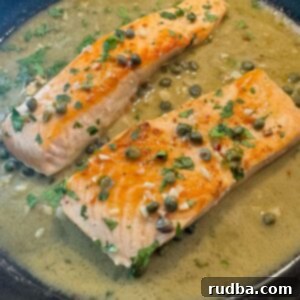
Salmon Piccata Recipe
Ingredients
- 2-3 salmon fillets
- ½ cup white wine , or chicken stock
- 4 tablespoons butter
- 2 garlic cloves , finely minced
- 2 tablespoons capers
- ½ lemon, juiced
- ½ teaspoon lemon zest
- salt , to taste
- red pepper flakes , to taste
- oil, for frying salmon
- fresh parsley, for garnishing
Instructions
- Season the salmon fillets on both sides with salt and pepper. Ensure the fillets are patted dry before seasoning for the best sear.
- Heat 1-2 tablespoons of oil in a large skillet (cast iron or stainless steel works best) over medium-high heat until shimmering. Carefully add the salmon fillets, skin-side down if applicable, to the hot skillet. Cook for 2-4 minutes on each side, or until the salmon reaches an internal temperature of 145 degrees F (63°C) and the flesh is opaque and flakes easily. Remove the cooked salmon from the skillet and set it aside on a plate, tented loosely with foil to keep warm.
- Reduce the heat to medium. Add 2 tablespoons of butter to the same skillet, allowing it to melt and foam slightly. Stir in the minced garlic, lemon zest, and red pepper flakes (if using). Cook for about 20-30 seconds, stirring constantly, until fragrant. Be careful not to burn the garlic.
- Pour in the white wine (or chicken stock) and freshly squeezed lemon juice. Add the capers. Increase the heat slightly and bring the sauce to a gentle simmer. Cook for 2-3 minutes, scraping the bottom of the pan with a wooden spoon to release any browned bits (fond) and allowing the liquid to reduce by half. This concentrates the flavors of your piccata sauce.
- Remove the skillet from the heat. Stir in the remaining 2 tablespoons of cold butter, swirling the pan continuously or whisking gently until the butter is fully melted and incorporated, creating a silky, slightly thickened sauce. Season the sauce with additional salt and pepper to taste, if needed.
- Carefully place the cooked salmon fillets back into the skillet with the piccata sauce. Spoon the luscious sauce generously over the salmon to coat it thoroughly. Garnish with fresh chopped parsley for a burst of color and herbaceous flavor. Serve immediately with your favorite side dishes and enjoy your delicious, homemade Salmon Piccata!
Notes
- Whatever you do, don’t overcook the salmon otherwise, it will turn out tough and dry and resemble canned tuna! I like to cook it for 3 minutes on each side depending on the thickness. If the fillets are on the thicker side, I will do 4-5 minutes on each side over medium heat. Always aim for an internal temperature of 145°F (63°C).
- Season your salmon with Kosher salt and freshly ground black pepper on both sides for maximum flavor! Don’t forget to pat the salmon dry before seasoning for a better sear.
- Make sure to scrape the bottom of the pan the second you add the lemon juice and chicken stock/white wine. This “deglazing” step incorporates all the flavorful browned bits into your sauce, adding depth.
- Take the salmon out of the fridge 15-20 minutes before cooking it. If the salmon is too cold, it will cook unevenly, leading to a less desirable texture.
Nutrition
Nutrition information is automatically calculated, so should only be used as an approximation.
